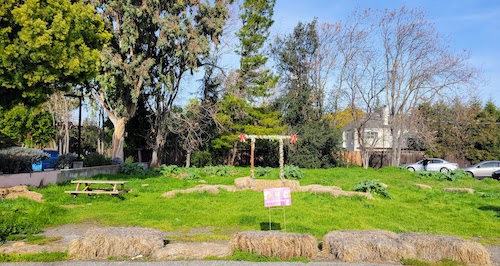I wrote last week about how difficult it is to hang onto our open spaces in the face of development pressure and land constraints. We need policies to protect these spaces and politicians to champion and enforce those policies. We love our open spaces, but even so it’s not easy to keep them.
The good news, however, is that there is much more we can do with the open space we do have, especially when it comes to creating inviting habitat for birds, insects, butterflies, caterpillars, and other wildlife. Look around you and I think you will see the potential.
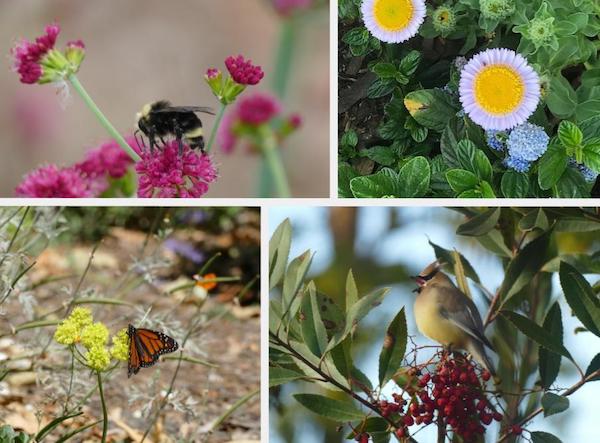
Native plants support local birds, bees, and butterflies
>> Plant Natives
Our wildlife evolved in partnership with local (native) plants, so native plants provide the best resources for our local fauna. Gardeners are increasingly switching to natives to sustain the local food web as well as to save water. Several years ago, some Palo Alto residents decided to take on the bare spaces along Embarcadero Road, replacing them with native pollinator gardens. They have created and now maintain seven gardens (and counting!) in that area, with help from local volunteers.
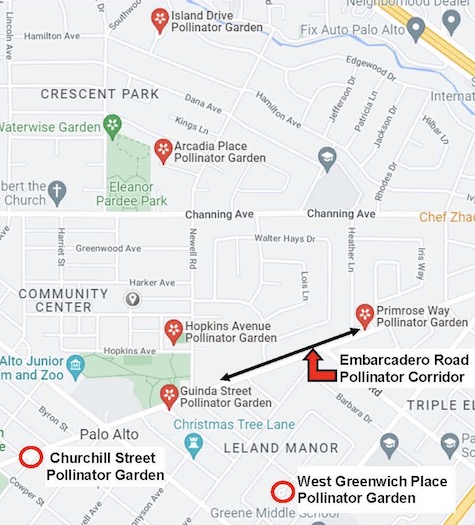
Source: December 2022 Pollinator Post newsletter
These gardens feature native plants that provide food and shelter for insects, birds, and butterflies. You can stop by to see the plants and look for the the local wildlife they are supporting.
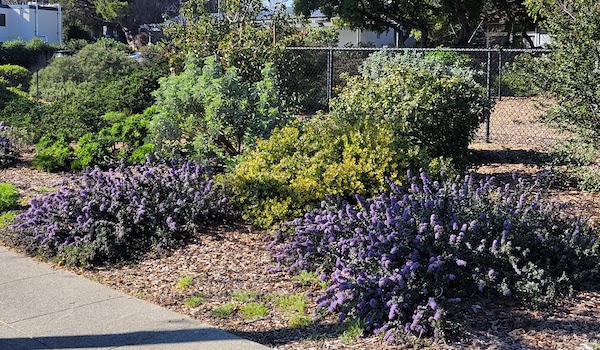
Native shrubs in front of the Unitarian Universalist Church at 505 East Charleston in Palo Alto. The California lilacs were swarming with bees when I took this photo.
In South Palo Alto, the Unitarian Universalist Church on Charleston has a beautiful native garden that they put in a few years ago. Barron Park’s Bol Park has a variety of native plants, well labeled, put in with help from Grassroots Ecology and the Barron Park Native Habitat Committee. I encourage you to stop by these places, not only to look but also to smell. Some of the sages and other plants -- mint, lavender, lilac -- have wonderful aromas.
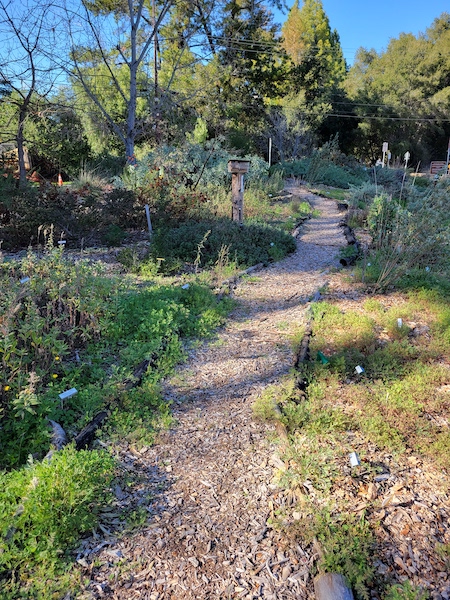
Native plantings in Palo Alto’s Bol Park. The path is lined with downed wood, and a small “bee hotel” stands in the middle.
There are many improvements we can make to our own homes as well. I have a yard with lots of plants, but many are not great for wildlife. For example, I have dozens of nandinas. They look nice and the berries last a long time. Unfortunately, that’s because birds won’t eat them -- they are poisonous! An alternative like toyon or manzanita would look just as nice and provide much better habitat.
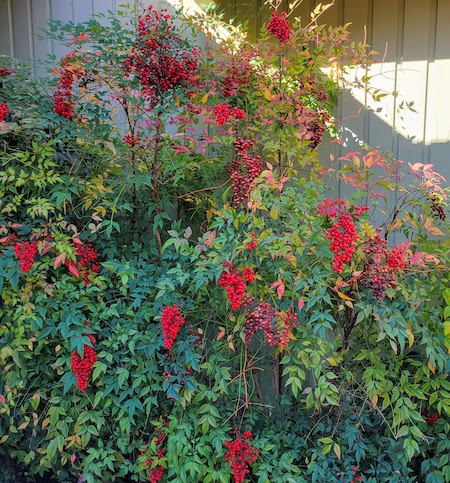
Nandina berries next to my house are toxic for birds. I am eager to replace these poisonous plants.
Conservationist Doug Tallamy has written and spoken at length about why native plants are so important, and why now is the time to use smaller private spaces like our yards and street strips to augment larger open spaces. He gave a great talk recently for the local Audubon Society chapters, emphasizing the importance of providing food and habitat for caterpillars, which are irreplaceable sustenance for most species of baby birds.
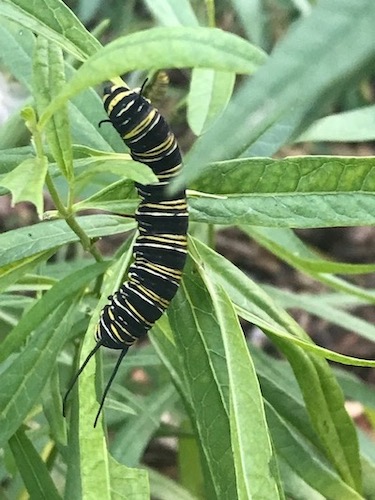
A monarch caterpillar munching on milkweed
Any household with a small patio or balcony can participate in container gardening with keystone natives. “Keystone species” are plants that provide critical support for our food web. For our area, you can find lists here and here. For natives more generally, Calscape allows you to enter your home's address and see which natives will do well. The Audubon Society offers a lookup by zipcode. These are terrific resources for when you have a new spot to plant.
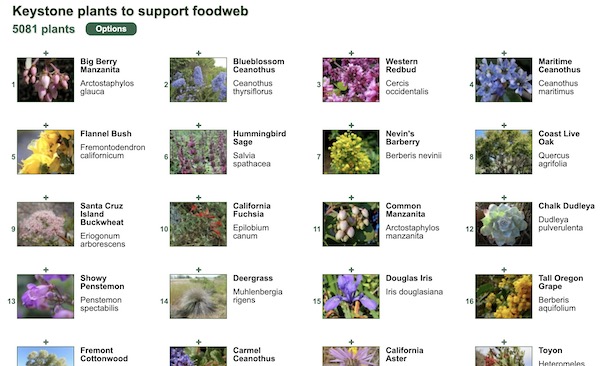
Lots of information about keystone plants is available online, such as this page from Calscape
For more inspiration on native plantings, you can check out pictures from local native garden tours (Peninsula to San Jose and East Bay), and consider signing up for a tour this spring. To buy plants, SummerWinds in Palo Alto has a good selection and expert advice, and you can find native plant vendors near you.
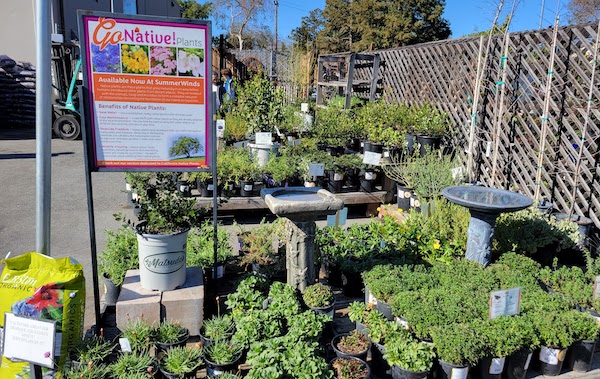
Some of the native plants at Summer Winds in Palo Alto
>> Be a (Thoughtfully) Lazy Gardener
There’s more to supporting habitat than planting. Here are some maintenance tips.
Leave downed wood in your yard. Many of us lost tree limbs during the storm. If you can leave some of that wood on the ground, it is a great home for fungi, insects, and other life, which in turn provide food for birds, possums, and so on.
Keep dropped leaves on the ground. These help maintain moisture in the earth, provide nutrients for the soil, and provide shade and shelter for wildlife, including pupating caterpillars.
Go easy on plant trimming. If you leave your shrubs bushy and let seed pods remain on your plants, it will make for better habitat -- more shelter, more food.
Mow less. If you have a lawn, longer grass helps to save water and provides more shade for insects. Better yet, reduce your lawn size, mow even less, and enjoy more habitat-friendly plants.
Keep a quiet nesting season. Especially March through July it’s good to avoid big projects in your yard, stay away from trimming trees and shrubs, and generally keep things quiet. If you are doing a big project during that time, consider removing or sealing off any bird boxes you have for the season so that you aren’t creating a stressful home.
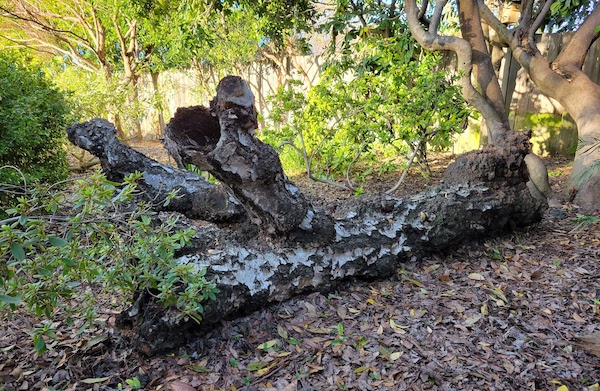
Downed wood and leaf mulch provide food and shelter
If you have a gardener, you can ask him or her to learn more about sustainable yard maintenance. Santa Clara Valley runs a Green Gardener Program with low cost classes. Alternatively, you can look at their list of certified gardeners. Small things can make a big difference, and many of them involve doing less work than usual. A knowledgeable gardener should proactively discuss with you the benefits of keeping leaves on the ground, reducing use of pesticides, and more.
>> Take on a High Value Project (or Two!)
There are more things you can do that involve a little bit more time and/or cost than “lazy gardening” but provide outsized value for wildlife. Here are some examples.
Water. Birds, bees, and more need water in the warmer months. A tray of water or a small bubbling fountain can make a big difference. You can find solar birdbath fountains and DIY fountains and simple bird baths on the internet, along with more elaborate fountains, ponds, and waterfalls. Water is one of the most important elements you can add to an outdoor garden habitat.
Shelter. Many birds require cavities for nesting, and that’s where bird boxes come in. These are inexpensive wooden homes that can be mounted on a tree, a pole, or even a fence post. There are per-species DIY plans here, or you can buy them online. You can also consider boxes for owls and bats.
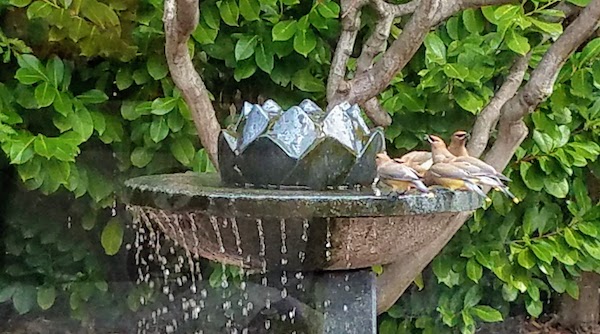
Cedar waxwings enjoy a backyard water fountain
Dark nights. The key here is to keep your yard as dark as possible at night, and especially to avoid high-frequency light. Light that looks bluer or whiter, rather than yellower, is more attractive and therefore more dangerous to moths. The more moths we kill, the fewer caterpillars we will have, and those are essential food for baby birds. It is a good idea to use motion sensors instead of switched lights. You can also make sure that LED lights that are placed outside or are visible from outside are “warm white” (e.g., 2700K). If you (or your kids!) tend to leave on interior lights that are visible from outside, you can put a timer on the switch that turns them off at a certain time. Automatic shades are also available, but pricier. All of these steps make for a darker yard, which is important for our ecosystem.
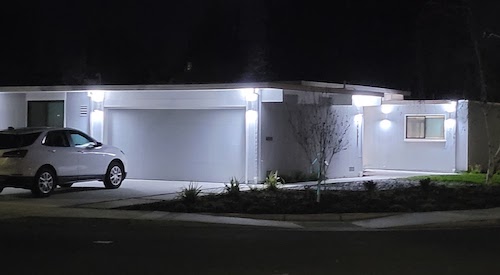
This house would be easier on wildlife if the lights were on sensors and had warmer colored bulbs.
Poison-free. Pesticides and rodenticides can kill all manner of beneficial species from honey bees to song birds to bobcats to eagles. But avoiding them can take extra work. Without pesticides, you may have to do some additional weeding, especially of invasives like bind weed (morning glory) and oxalis. Mulch (and leaf litter!) can help to keep weeds down. There are alternatives to poison for killing mice and rats. I’ve used electric traps before with good success.

The poison pellets and bait stations shown here will kill animals all the way up the food chain.
>> Change Your Perspective
It’s an interesting exercise to look at our outdoor spaces through the eyes of our fellow inhabitants -- birds, butterflies, caterpillars, insects, and so on -- and to think about what we can do to foster biodiversity in our shared spaces. There is a lot of low-hanging fruit here, with projects for all ages and benefits for people as well as our local wildlife. Each of us can make a positive change while enjoying the process and the results.
Current Climate Data (December 2022)
Global impacts, US impacts, CO2 metric, Climate dashboard
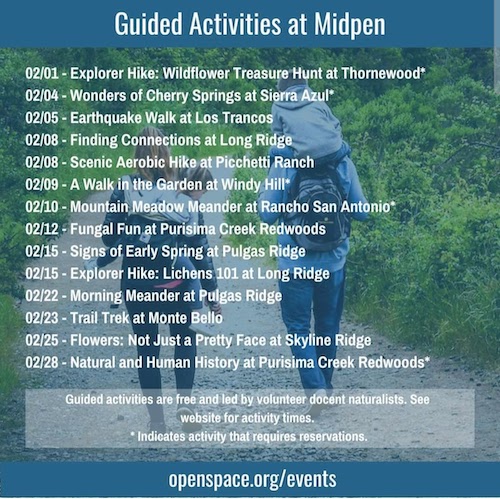
There are lots of opportunities this next month to get out and learn more about our natural environment at the Midpeninsula Open Space Reserves.
Comment Guidelines
I hope that your contributions will be an important part of this blog. To keep the discussion productive, please adhere to these guidelines or your comment may be edited or removed.
- Avoid disrespectful, disparaging, snide, angry, or ad hominem comments.
- Stay fact-based and refer to reputable sources.
- Stay on topic.
- In general, maintain this as a welcoming space for all readers.




